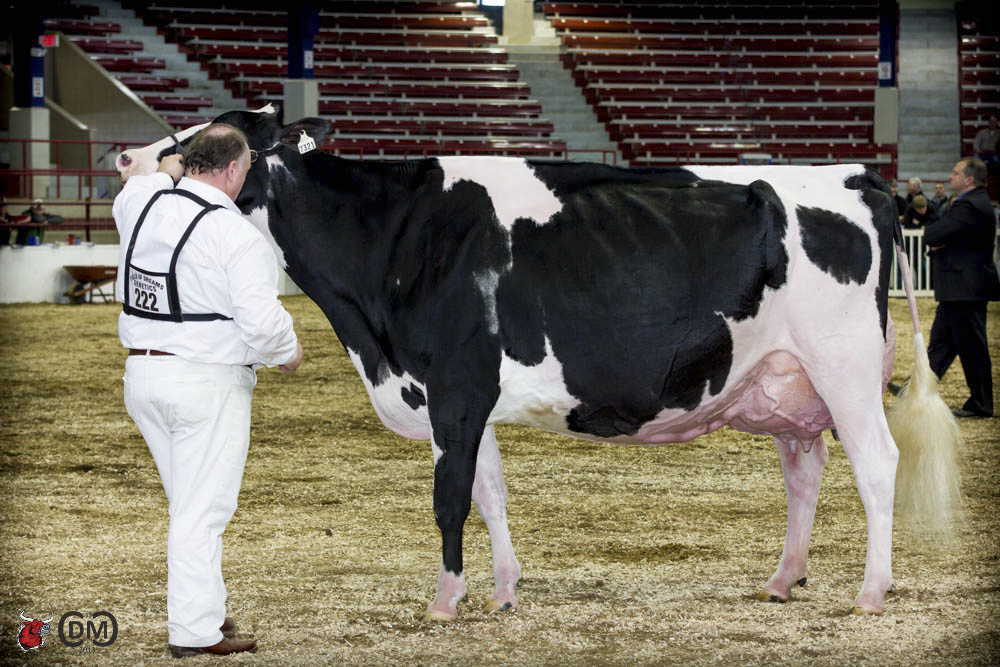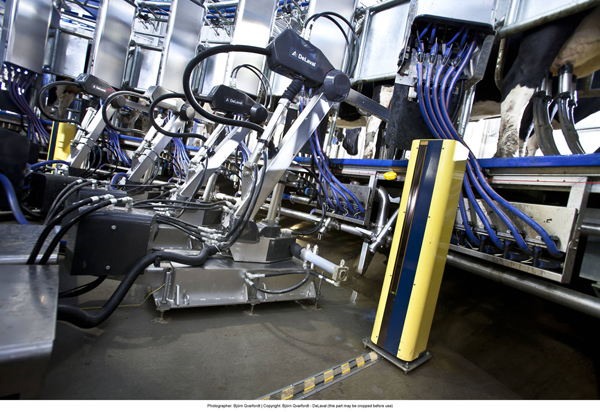Over the past couple of weeks I have heard numerous references to the word ‘balance’ when referring to the dairy cattle breeding industry. Do we over use the term? Or worse still do we use it incorrectly? At this moment I am thinking ‘yes I don’t think we do justice to the word when it comes to genetically advancing our dairy cattle’. But let’s take a look at how we do use the term.
Numerous Interpretations
Two weeks ago at the Quebec Holstein Spring Show (Read more: Do We Speak the Same Language? and Quebec Spring Show Results) I had the opportunity to converse with a veteran dairy farm manager from Europe who spoke to me about balancing his time between breeding better cattle and the economics of running a successful dairy farm.
A week ago today a breeder, who was about to receive his Canadian Master Breeder Shield, defined for me balanced breeding as placing equal emphasis on production and type when he selects bulls and culls cows (Read more: Holstein Canada Annual Meeting 2012 – From Coveralls to Niagara Falls).
Last Thursday at the Ontario Dairy Discovery Show (Read more: Ontario Spring Discovery – Nothing Slipped Past Judge “Crack” and Ontario Spring Discovery Results) a breeder who regularly exhibits cattle at all levels described to me that balanced breeding was breeding for type and then feeding for production.

RF GOLDWYN HAILEY EX-97-CAN
Considered by many to be one of the most balanced conformation cows in the history of the Holstein breed.
On Friday at the Canadian Holstein Annual Meeting, an attentive audience heard Chief Classifier, Tom Byers (Read more: TOM BYERS: “THAT’S CLASSIFIED!”), describe that a cow’s parts need to be in balance. “That varies depending on whether you are looking at a just fresh 24 month old heifer or a mature cow 120 days in milk in her sixth plus lactation” said Byers.
This past Monday, as I attended the New York Spring Holstein Show (Read more: RF Goldwyn Hailey Rides to the Top Spot at NY Spring Carousel and New York Spring Holstein Show 2013 Results), I heard balance or balanced used in four other ways. A sire analyst spoke about getting the sires of sons from a balance of daughter proven and genomic evaluated bulls. Richard Keene past Holstein USA Director and very well respected cattle judge used balance in two different ways. First he spoke about the importance of balancing the emphasis being placed on cows and bulls in genetic advancement. Secondly he spoke about balancing the needs several ways – breed improvement, lifetime milk production, profits cows return to the enterprise and serving senior versus junior members. And finally the 2013 NY Holstein Spring Show Judge Michael Heath spoke about a cow having balance between dairyness and enough capacity to consume, balance in her mammary system and balance between high at the front end and ability to walk with ease.
Are you still with me? So many uses of the word. I am sure you may be able to add other ways that you use the word balance. So why so many ways of interpreting balance?
Digging Deeper
Like beauty, balance appears to be in the eye of the beholder or the reality of the breeder.
Gerrit Wensink, EastGen Director, who milks 400 cows using six robots he feels that the Canadian Holstein Cow has improved her conformation to the point where in sire selection his emphasis is on milk component percentages and calving ease. Whereas some breeders, who will be dispersing their herds in the next few years, want to have animals for sale that will bring the highest price. And then other breeders may want to maximize revenue per stall, profit per cow per day or daily production of fat & protein per cow. Still other breeders want to minimize costs. Minimal labour per animal, minimal health problems, the lowest replacement cost per cow per year or put in a different way the lowest reproduction costs per cow per year.
So each of us has a different definition of what Balanced Breeding means to us.
Breed Guidance
To assist breeders, organizations have developed total merit indexes that breeders can use in selection and culling. Holstein USA ranks animals using the TPI™ index. Canadian breeders have the LPI (Read more: Everything You Need To Know About TPI and LPI and TPI™ and LPI – Marketing or Mating tools?). And USDA geneticists rank animals using the Net Merit index. In fact almost every country, region or continent has a total merit index. All these indexes have many traits included with each weighted according to economic values. Breeders are encouraged to use these indexes for both genetic and marketing purposes. Yet do they in fact maximize both breed advancement and breeder profitability?
Some History – Current Needs
At various times in their histories breeds have identified major needs and focused on those needs. Holstein have genetically address low butterfat content, deep udders and high somatic cell counts. While the other breeds have all addressed low volume of milk produced. But what are breeders’ current most major needs? Genetically for the Holstein breed they could well be rear foot conformation, fertility and perhaps even feed efficiency. Are they the same for all cow housing systems? Are they different for in tie stall barn pipeline milked, parlour milked or robotically milked cows (Read more: Robotic Milking: More than just automation it’s a new style of herd management). And yes beyond the cow, breeders also face the challenges and opportunities associated with animal welfare and increasing the profit per cow per day of life.
One young South American dairy couple recently told me that they see it quite differently. They want to breed for fat & protein yield plus fertility and manage for conformation and health. So they are only using the highest genomically evaluated Holsteins bulls for fat, protein and fertility that they can find anywhere in the world. Their idea is to drive up revenue per cow and keep costs under control.
Considering all factors, some of which may not have a genetic component, when breeding for improvement it gets to be a big challenge and perhaps we could even say complicated.
The Reality Is
There is no such thing as uniformity of breeder needs when it comes to Balanced Breeding. Total merit formulas are for the average but do not address the top priorities. For instance breeding for enhanced rear feet is very difficult as the trait is not uniformly measured and what genetic differences are known are lost when a Feet & Leg rating is produced for a bull. Definitely when it comes to the genetic difference between animals in genetic merit for fertility, we are just starting to scratch the surface.
For interest sake the Bullvine has produced articles that change the emphasis placed on traits (Read more: Bullvine Performance Index (BPI – Top Sires December 2012 and Top BPI Heifers from Around the World ) and we even produced a bull index for daughter feed efficiency ((Read more: 30 Sires That Will Produce Feed Efficient Cows). Some AI organizations also produce their own bull ranking indexes that place emphasis on major breed needs. However all of these total merit indexes come up with numbers that water down the greatest genetic needs. The end result is that we select for so many traits that we average everything out and make less than optimal progress for the areas of greatest need.
The reality is we will not make significant progress for the areas of greatest genetic need until breeders routinely use the bulls that rank in the top 1-5% of the breed. For traits like feet and female fertility for milking cows there are not even listing produced that give the top ranking bulls of the breed. How can breeders address their biggest needs when they do not have access to the best bulls there are genetically.
The Bullvine Bottom Line
Balance Breeding formula are for the masses but not for the breeders truly committed to improving their herds for their greatest genetic needs. Total merit indexes are a good first sort tool for getting a short list of bulls. However breeders truly interested in genetically attacking their most limiting traits, in improving their herds and in having the facts to show when marketing their genetics, it is time to rethink if the Balanced Breeding is the right approach. To move forward genetically requires that breeders select only the best and ignore the rest.
Get original “Bullvine” content sent straight to your email inbox for free.



















Leave a Reply
You must be logged in to post a comment.